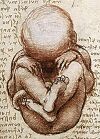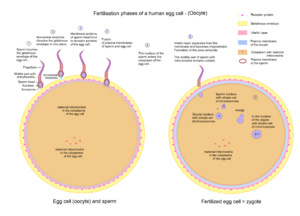لاقحة
| Zygote | |
|---|---|
 Zygote formation: egg cell after fertilization with a sperm. The male and female pronuclei are converging, but the genetic material is not yet united. | |
| Details | |
| Days | 0 |
| Precursor | مشيجان |
| ينشئ | Blastomeres |
| Identifiers | |
| MeSH | D015053 |
| TE | E2.0.1.2.0.0.9 |
| FMA | 72395 |
| المصطلحات التشريحية | |
| جزء من سلسلة عن |
| تطور ونمو الجسم البشري |
|---|
 |
| المراحل |
| المحطات الحيوية |
| التطور وعلم النفس |
اللاقحة ( Zygote ؛ /ˈzaɪˌɡoʊt/; من يونانية قديمة ζυγωτός (zygōtós)، وتعني "joined, yoked", من ζυγοῦν (zygoun)، وتعني "to join, to yoke")[1] هي الخلية حقيقية النواة التي تنتج عن عملية الإخصاب (التلقيح) بين مشيجين gamete جينوم اللاقحة هو جمع للدنا في كلٍ من المشيجين، ويضم كل المعلومات الوراثية لعضية مفردة جديدة. الاندماج الجنسي للخليتين أحاديتي الصيغة haploid (عادة تكون نطفة و بييضة ) ليشكلا خلية ثنائية الصيغة diploid تدعى لاقحة، ويدعى karyogamy.
ومن صفات اللاقحة قدرتها على التحول إلى أشكال أخرى (أي يمكنها التتطور إلى اشكال مختلفة أخرى في خاصية يطلق عليها "tuttipotent cell"
التاريخ
German zoologists Oscar and Richard Hertwig made some of the first discoveries on animal zygote formation in the late 19th century.
في العضيات عديدة الخلايا
The zygote is the earliest developmental stage. In humans and most other anisogamous organisms, a zygote is formed when an egg cell and sperm cell come together to create a new unique organism.
The formation of a totipotent zygote with the potential to produce a whole organism depends on epigenetic reprogramming. DNA demethylation of the paternal genome in the zygote appears to be an important part of epigenetic reprogramming.[2] In the paternal genome of the mouse, demethylation of DNA, particularly at sites of methylated cytosines, is likely a key process in establishing totipotency. Demethylation involves the processes of base excision repair and possibly other DNA-repair–based mechanisms.[2]
البشر
In human fertilization, a released ovum (a haploid secondary oocyte with replicate chromosome copies) and a haploid sperm cell (male gamete) combine to form a single diploid cell called the zygote. Once the single sperm fuses with the oocyte, the latter completes the division of the second meiosis forming a haploid daughter with only 23 chromosomes, almost all of the cytoplasm, and the male pronucleus. The other product of meiosis is the second polar body with only chromosomes but no ability to replicate or survive. In the fertilized daughter, DNA is then replicated in the two separate pronuclei derived from the sperm and ovum, making the zygote's chromosome number temporarily 4n diploid. After approximately 30 hours from the time of fertilization, a fusion of the pronuclei and immediate mitotic division produce two 2n diploid daughter cells called blastomeres.[3] Between the stages of fertilization and implantation, the developing embryo is sometimes termed as a preimplantation-conceptus. This stage has also been referred to as the pre-embryo in legal discourses including relevance to the use of embryonic stem cells.[4] In the US the National Institutes of Health has determined that the traditional classification of pre-implantation embryo is still correct.[5]
After fertilization, the conceptus travels down the fallopian tube towards the uterus while continuing to divide[6] without actually increasing in size, in a process called cleavage.[7] After four divisions, the conceptus consists of 16 blastomeres, and it is known as the morula.[8] Through the processes of compaction, cell division, and blastulation, the conceptus takes the form of the blastocyst by the fifth day of development, just as it approaches the site of implantation.[9] When the blastocyst hatches from the zona pellucida, it can implant in the endometrial lining of the uterus and begin the gastrulation stage of embryonic development.
The human zygote has been genetically edited in experiments designed to cure inherited diseases.[10]
الفطريات
In fungi, this cell may then enter meiosis or mitosis depending on the life cycle of the species.[بحاجة لمصدر]
النباتات
In plants, the zygote may be polyploid if fertilization occurs between meiotically unreduced gametes.
In land plants, the zygote is formed within a chamber called the archegonium. In seedless plants, the archegonium is usually flask-shaped, with a long hollow neck through which the sperm cell enters. As the zygote divides and grows, it does so inside the archegonium.[بحاجة لمصدر]
في الأنواع الأخرى
اللاقحة ثنائية الوالدين biparental zygote هي Chlamydomonas (نوع من لاقحة الطحالب) التي تحتوي على chloroplast دنا (cpDNA) من كلا الوالدين.
في العضيات وحيدة الخلية
The zygote can divide asexually by mitosis to produce identical offspring.[بحاجة لمصدر]
A Chlamydomonas zygote contains chloroplast DNA (cpDNA) from both parents; such cells are generally rare, since normally cpDNA is inherited uniparentally from the mt+ mating type parent. These rare biparental zygotes allowed mapping of chloroplast genes by recombination.[بحاجة لمصدر]
انظر أيضاً
المصادر
- ^ "English etymology of zygote". etymonline.com. Archived from the original on 2017-03-30.
- ^ أ ب Ladstätter S, Tachibana-Konwalski K (December 2016). "A Surveillance Mechanism Ensures Repair of DNA Lesions during Zygotic Reprogramming". Cell. 167 (7): 1774–1787.e13. doi:10.1016/j.cell.2016.11.009. PMC 5161750. PMID 27916276.
- ^ Blastomere Encyclopædia Britannica Archived 2013-09-28 at the Wayback Machine. Encyclopædia Britannica Online. Encyclopædia Britannica Inc., 2012. Web. 06 Feb. 2012.
- ^ Condic, Maureen L. (14 April 2014). "Totipotency: What It Is And What It Is Not". Stem Cells and Development. 23 (8): 796–812. doi:10.1089/scd.2013.0364. PMC 3991987. PMID 24368070.
- ^ "Report of the Human Embryo Research Panel" (PDF). Archived from the original (PDF) on 2009-01-30. Retrieved 2009-02-17.
- ^ O’Reilly, Deirdre. "Fetal development Archived 2011-10-27 at the Wayback Machine". MedlinePlus Medical Encyclopedia (2007-10-19). Retrieved 2009-02-15.
- ^ Klossner, N. Jayne and Hatfield, Nancy. Introductory Maternity & Pediatric Nursing, p. 107 (Lippincott Williams & Wilkins, 2006).
- ^ Neas, John F. "Human Development" Archived يوليو 22, 2011 at the Wayback Machine. Embryology Atlas
- ^ Blackburn, Susan. Maternal, Fetal, & Neonatal Physiology, p. 80 (Elsevier Health Sciences 2007).
- ^ "Editing human germline cells sparks ethics debate". May 6, 2015. Archived from the original on May 18, 2015. Retrieved May 17, 2020.
طالع أيضاً
المراجع
| سبقه Oocyte + Sperm |
Stages of human development Zygote |
تبعه Embryo |

